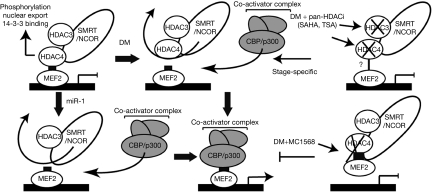Figure 4.
Regulatory complexes formed with MEF2 at responsive genes. Myocyte enhancer factor 2 (MEF2) recruits class II histone deacetylases (HDACs) such as HDAC4 to responsive genes, resulting in repression. HDAC4 binds to HDAC3 on a co-repressor (nuclear receptor corepressor (NCOR)/silencing mediator of retinoic acid and thyroid hormone receptor (SMRT)) platform. Differentiation medium (DM) results in the dissociation of the MEF2–HDAC4 interaction, allowing association of a co-activator complex and target gene expression, as CREB (cyclic AMP response element binding)-binding protein (CBP)/p300 and HDAC4 bindings to MEF2 are mutually exclusive. The miR-1 achieves the same effect by down regulating HDAC4. HDAC inhibition does not result in the same events as the removal of HDAC4. Pan-histone decetylase inhibitors (HDACi) block both HDAC3 and HDAC4 and, depending on the stage of myogenesis, might block or stimulate differentiation. By contrast, MC1568 blocks HDAC4 activity but enhances the HDAC4–MEF2 interaction, thus resulting in enforced repression. SAHA, suberoyl anilide hydroxamic acid; TSA, tricostatin A.

